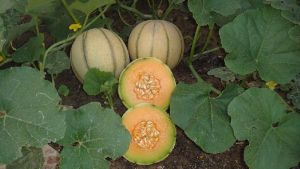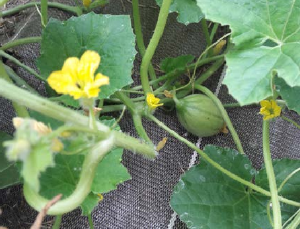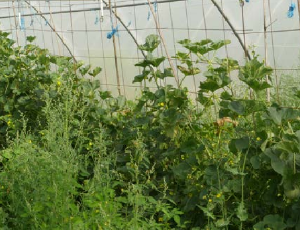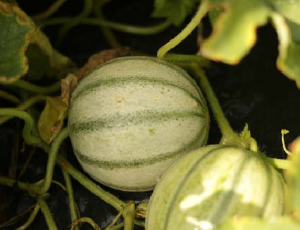Cucumis melo

The melon is an essential summer vegetable.
Unlike Solanaceae, melons are pruned on the main the main axes : cutting off the head of the melon plant of the melon plant encourages more vigorous more vigorous branches than the head of the plant.
Preparing the soil
Melons are a demanding crop and are sensitive to deficiencies (macro and oligo elements), an addition of plant compost or animal manure or animal manure can be added. Melon requires melon requires a hot, dry climate, it is grown mainly undertarpaulin under cover (except in regions with a mild, sunny climate). sunny climate). Melons require deep, rich soil with good with good water retention capacity and good drainage. drained. A living soil is therefore perfect. Growing mounds will improve drainage and soil temperature. soil temperature.
Planting


Sowing is carried out 2 to 4 weeks before planting in the best conditions. The crop, started nursery, is best grown on a woven fabricas silage tarpaulins woven fabric, as silage tarpaulins accumulate water, which can rot the fruit.
Melons need warm soil and mild temperatures to grow well.
temperatures for good establishment. To achieve ideal
ideal conditions in northern regions, cover the soil with a silage tarpaulin
with a silage tarpaulin after irrigation to warm it up
to at least 15°C.
Planting is done by hand and ideally at the stage of
2/3 true leaves. Later planting can be done at the
at the 1/2 leaf stage. The density is approximately one plant
every 50 cm on a 75 cm bed (i.e. 2.5 plants/m²).
Beware, this is a runner that invades driveways.
In sunny regions, it is possible to grow courgettes in the same way
courgette, it is possible to plant early series under cover and
in the open field.
Tip : White tarpaulins can be used to increase the amount of sun this light-hungry crop receives.
Crop monitoring

Covering with a tarpaulin eliminates the need for weeding. Pruning allows earlier ripening, especially for older varieties by encouraging the appearance of female flowers. Prune first time above the second leaf, then the branches above the third leaf. The branches two leaves above the selected fruit.
On average, 3 to 6 fruits per vine are kept. To encourage ripening at the end of the season, remove leaves that shade the fruit. that shade the immature fruit. All these operations should be carried out in dry, sunny weather. Hybrid varieties cannot be pruned, as this limits the amount of row coverage. Melons are trained with grafted varieties grafted varieties and in sunny regions.
Irrigation
Melons are irrigated by drip irrigation, avoiding watering with cold water. Avoid sprinklers, which encourage the development of diseases, such as powdery mildew, to which the to which melons are quite susceptible. Irrigation should be regular but not excessive, although it should be increased as the fruit matures. as the fruit matures.
Harvesting
Harvest several times a week, by hand, when ripe. For embroidered Charentais, a crack determines when it is harvesting time. The petit gris de Rennes changes colour. The fruity smell and appearance are also clues.
Ideally, harvesting the melon 2 to 3 days before fullripening ripeness allows longer storage. Before that, the melon will not be sweet enough, afterwards the sugars will be alcoholic. The harvesting period is generally very tightly grouped (2/3 weeks at the end of August and beginning of September).
Varieties
- Petit gris de Rennes, very good but susceptible to oidium.
- Numerous hybrid varieties : Artemis, Jenga, Tonga, etc.
Storage
Melons that are already fully ripe should be stored in a cool place (8°C) for 7 to 10 days. Less mature melons ripen at room temperature. Some market gardeners pick melons a little before ripening and leave them to ripen in the sun.
Pests and diseases
- Melons are subject to attacks by aphids.
- Powdery mildew affects the crop in dry weather. It damages plant development and limits the sugar content of ripe fruit. There are hybrid varieties that are resistant to these two health problems.
- Beware of rodent or bird attacks when the melons are ripe. Cats can be used to combat this.
Adapting to the soil and climate
This crop is best suited to warm, sunny regions where it can be grown earlier, with several sets and better yields. and better yields.
Photo gallery
Sources
- This page is based on the guide Introduction au maraîchage sol vivant from MSV Normandie.
